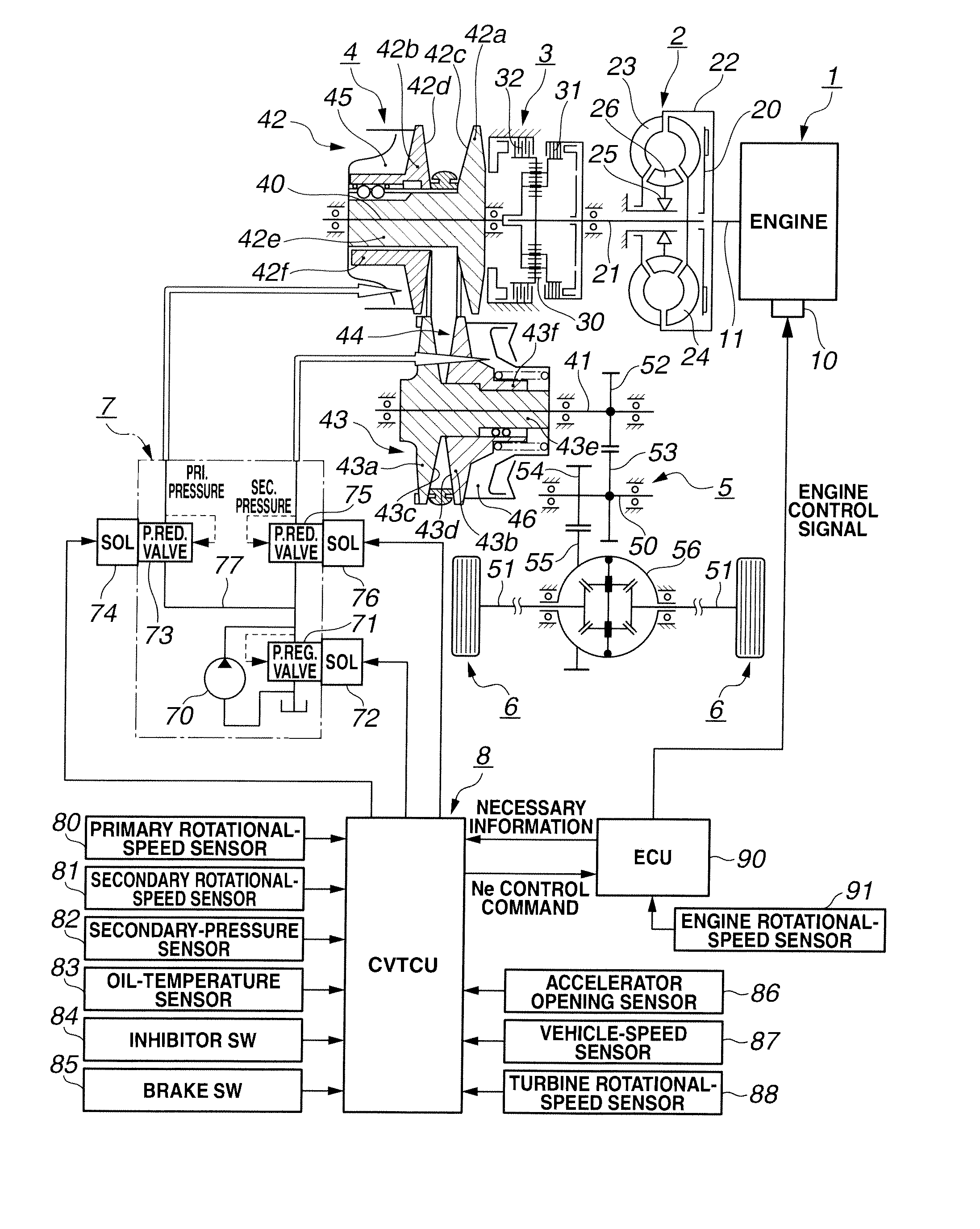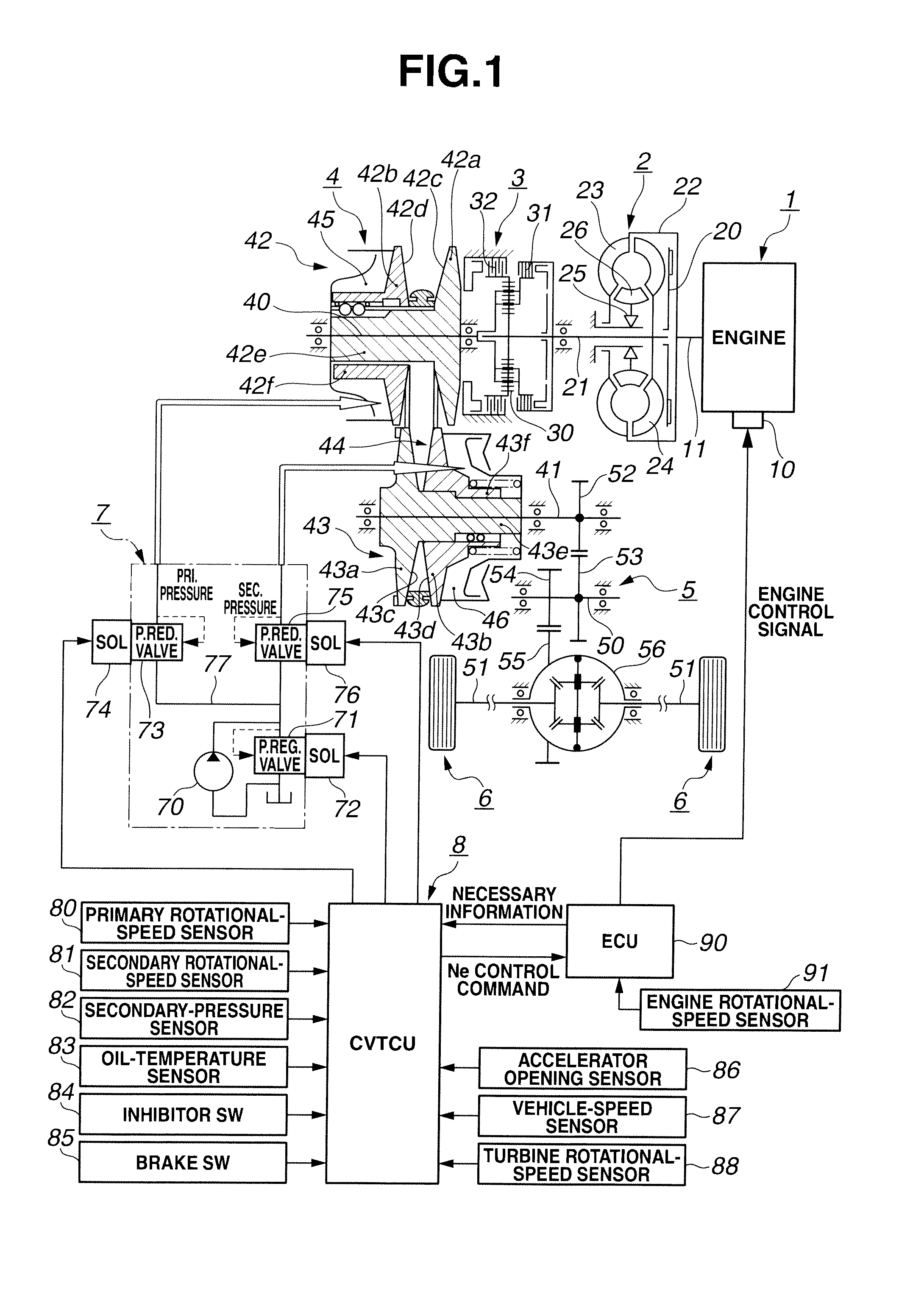Control apparatus for vehicle equipped with continuously variable transmission
a technology of transmission apparatus and control apparatus, which is applied in the direction of gearing control, gearing elements, gearing timing, etc., can solve the problems of late shift progression rate (advance speed) to the lowest region, late recovery response of power transfer, and late start timing of low shift control of vehicle-stop. it can improve the acceleration-performance of the vehicle and shorten the time length. , the effect of improving the time length
- Summary
- Abstract
- Description
- Claims
- Application Information
AI Technical Summary
Benefits of technology
Problems solved by technology
Method used
Image
Examples
first embodiment
[0034]At first, a configuration will now be explained. FIG. 1 is a schematic view showing drive system and control system of an engine vehicle equipped with a belt-type continuously-variable transmission (as one example of a vehicle having a continuously-variable transmission) in the first embodiment. Hereinafter, a schematic system configuration in the first embodiment will be explained referring to FIG. 1.
[0035]As shown in FIG. 1, the drive system of the engine vehicle equipped with the belt-type continuously-variable transmission in the first embodiment includes an engine (drive source) 1, a torque converter 2, a forward / reverse switching mechanism 3, the belt-type continuously-variable transmitting mechanism (continuously-variable transmission) 4, a final reduction gear mechanism 5, and drive wheels 6 and 6.
[0036]The engine 1 includes a rotational-speed control actuator 10. The rotational-speed control actuator 10 controls an output torque of the engine 1 in accordance with an a...
second embodiment
[0147]In a second embodiment according to the present invention, the engine idle-speed increasing control is omitted from the vehicle-stop LOW shift control.
[0148]At first, a configuration will now be explained. FIG. 7 is a flowchart (vehicle-stop LOW shift control means or section) showing flow and configuration of processing of the vehicle-stop LOW shift control which is executed by the CVT control unit 8 in the second embodiment. Respective steps of FIG. 7 will now be explained. Since step S21, step S22 and step S23 of FIG. 7 are same as step S1, step S2 and step S3 of FIG. 2, explanations thereof will be omitted for purpose of simplification of the disclosure.
[0149]At step S24 subsequent to step S21 or step S22, the control unit (the CVT control unit 8) carries out a vehicle-stop LOW shift aborting control in a case that the vehicle-stop LOW shift control (the pulley LOW shift control and / or the clutch half-engagement control) is currently being carried out. Then, the program is...
third embodiment
[0170]In a third embodiment according to the present invention, the power-transfer amount of the forward clutch 31 is gradually reduced toward a target power-transfer amount for the forward clutch 31 under the clutch half-engagement control.
[0171]At first, a configuration will now be explained. FIG. 9 is a flowchart (vehicle-stop LOW shift control means or section) showing flow and configuration of processing of the vehicle-stop LOW shift control which is executed by the CVT control unit 8 in the third embodiment. Respective steps of FIG. 9 will now be explained. Since respective steps S31-S35 of FIG. 9 are same as steps S1-55 of FIG. 2, explanations thereof will be omitted for purpose of simplification of the disclosure.
[0172]At step S36 subsequent to step S33, the control unit carries out a vehicle-stop LOW shift control (the clutch half-engagement control, the engine idle-speed increasing control and the pulley LOW shift control). Then, the program is returned. At step 36, the ve...
PUM
 Login to View More
Login to View More Abstract
Description
Claims
Application Information
 Login to View More
Login to View More - R&D
- Intellectual Property
- Life Sciences
- Materials
- Tech Scout
- Unparalleled Data Quality
- Higher Quality Content
- 60% Fewer Hallucinations
Browse by: Latest US Patents, China's latest patents, Technical Efficacy Thesaurus, Application Domain, Technology Topic, Popular Technical Reports.
© 2025 PatSnap. All rights reserved.Legal|Privacy policy|Modern Slavery Act Transparency Statement|Sitemap|About US| Contact US: help@patsnap.com



